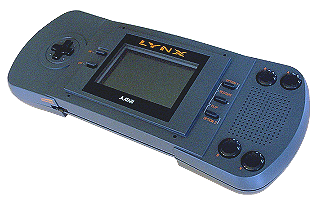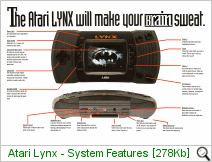|

The Lynx was the most
advanced hand-held console developed for nearly 10 years, and still
stands up to the current offerings available today.
Atari
purchased the original Lynx system from Epyx Corp., where RJ Michel (who
also worked on the Amiga 1000 chipset) was working
on the project with his team. Epyx wanted to produce the system themselves, but
financial restrictions forced a sale to Atari. RJ Michel said "We didn't
believe it had a chance of surviving when it was sold to Atari. Sadly for us, and
sadly for a lot of people, it turned out to be true. We resisted as much as we could
having the thing [Lynx] go to Atari, and when we were unsuccessful we resigned from the
company [Epyx]".
Although several companies had been invited
by Epyx (including Nintendo) to view the project in 1987, it was Atari
who eventually got the technology. Several features were dropped
from the original concept design (called "Handy"), including an infrared
communications port named RedEye, this eventually became a cable-network
device known as ComLynx). Atari had its first units ready
for preview at the Summer 1989 Consumer Electronics Show in Chicago.
The provisional name for the unit was the "Portable Colour Entertainment
System", but this was quickly changed by Atari marketing, and it was
given the name Atari "Lynx" for launch.

The Lynx sold extremely well, over a million units shipped, and new units
can still be purchased today from third party companies. The first
Lynx was expensive, $189 at launch - but the price soon came down.
Atari re-designed the Mark 1 Lynx, into a smaller chassis with improved
battery life. Called the Lynx II, it enabled Atari to manufacture
the product more cost effectively.

Atari
wanted to "kill" the Gameboy, but in what some would say was
typical Atari style, they wrangled with Casio over the LCD
screens and missed manufacturing targets for Christmas 1990 by 50%...
In 1991
Atari shipped 60 Lynx Units to troops in the Gulf War - 15 kiosks, each
containing 4 units were sent to recreation centres in Saudi Arabia; the
booths were similar to those seen at computer shows. Atari decided
to send the units after a G.I. sent a letter to the company asking for
"a sun visor to help play Lynx games in the desert". Atari also
ensured troops could buy systems at cost price! Commenting, Sam
Tramiel couldn't resist a customary dig at rival Nintendo saying "We're
sending American technology to the desert".

The Lynx MK.II was a complete re-design of
the launch machine. The MK.I wasn't exactly a portable system in comparison with the
Gameboy, and had to be cut down in size; another improvement had to be made with the
battery life and so Atari went to work and did a great job on the last Lynx ever produced.
The new
unit was lighter, easier to hold and battery life was, a little better.
It is still one of the most advanced hand-held systems available,
although, sadly it is not manufactured anymore. It is estimated
that the last units were produced in 1995, as it was been marketed in
tandem with the Jaguar.
|